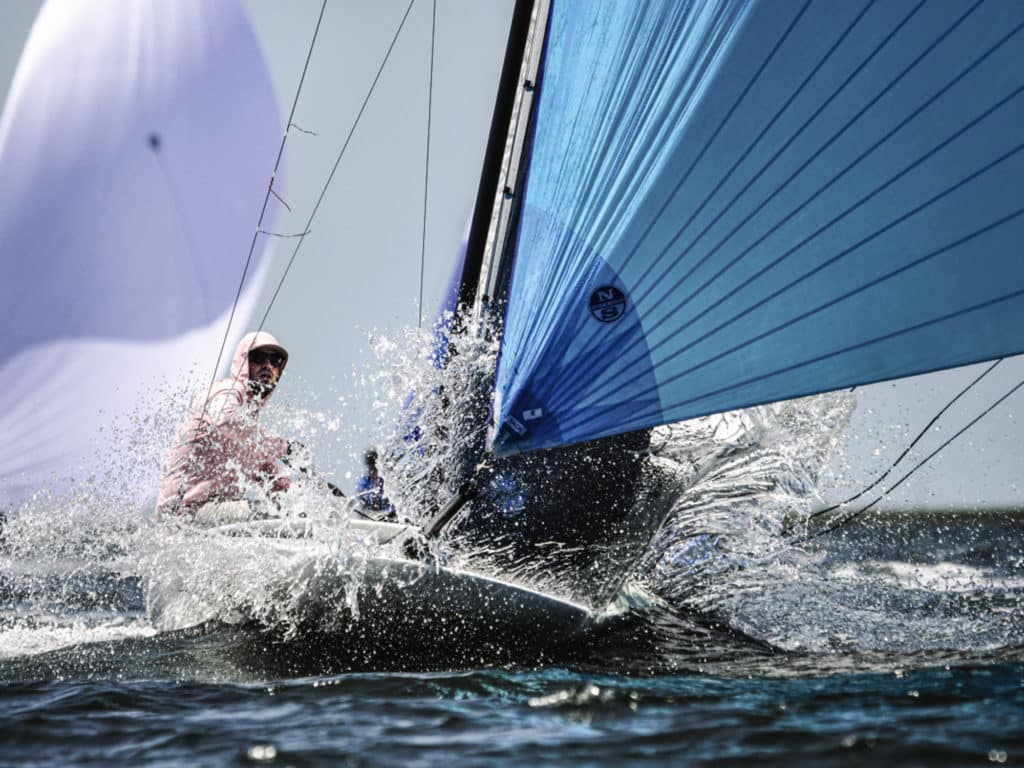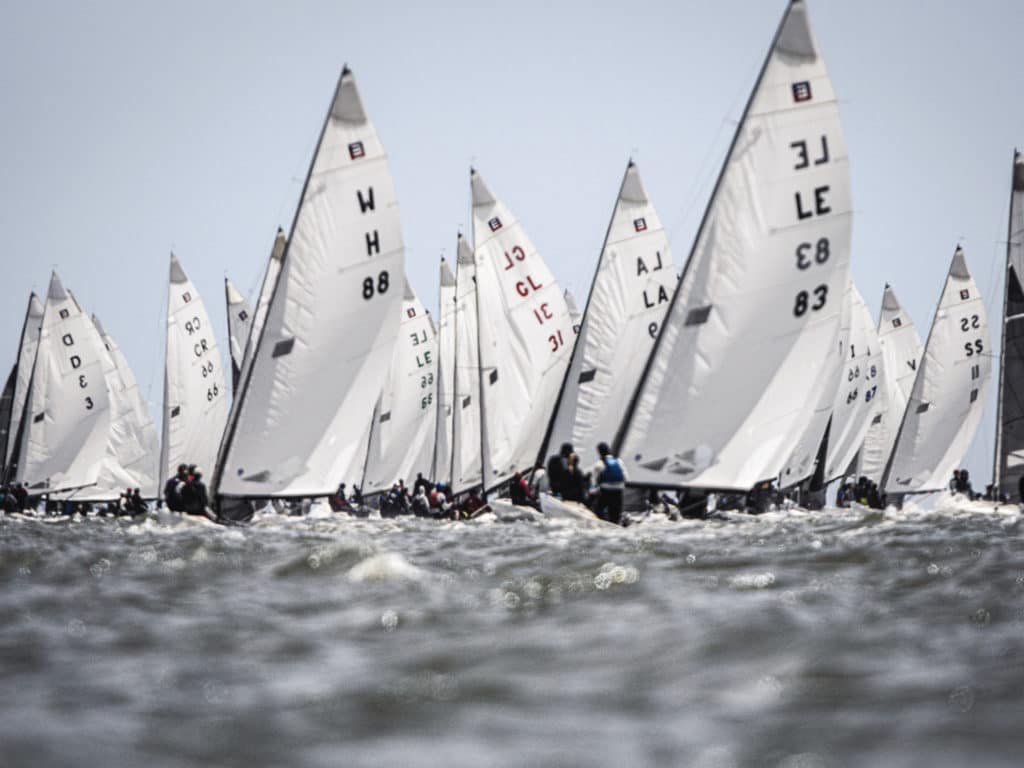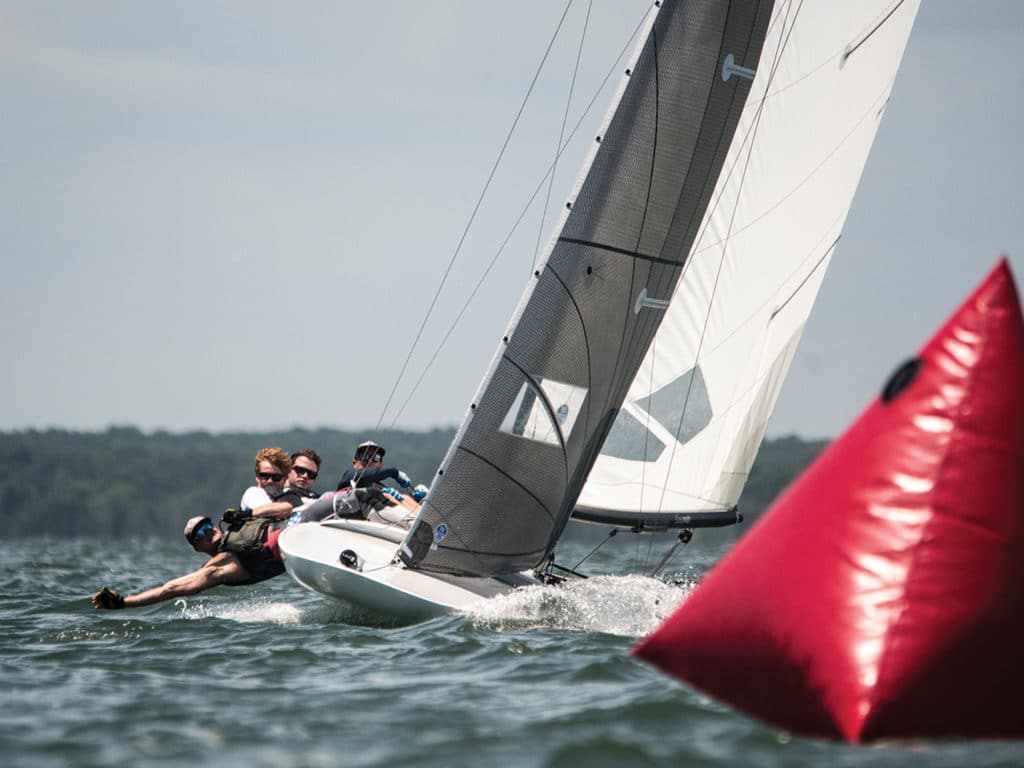
As the wind builds to 20 knots, eager crews on board 56 E Scows inch toward the starting line, sails flapping noisily. The race committee’s air horn sounds the start, and the fleet lurches forward, a densely packed swarm of white sails and low-slung surfboardlike hulls. But then there’s another horn. It’s a general recall, and the fleet returns to the line one by one. For its second attempt at a clean start, the race committee takes drastic action and hoists the dreaded black flag. Like scolded children, the fleet behaves, and five minutes later, 216 sailors shoot across the line toward the first mark of the course. New Jersey’s Little Egg Harbor is a choppy mess, which makes it tough-going on these flat-bottom scows. In less than two minutes, there’s a clear divide between the front and back half of the fleet. The faster teams surge into the lead, while the slower boats swiftly trail behind.
Among the front-runners in this race is 20-year-old Harry Melges IV, who had been penalized with a black-flag disqualification the previous day. Understandably, he is hoping for at least six races so he can discard his BFD score. Melges and his young crew of Kyle Navin, Finn Rowe and Ripley Shelley are sailing fast. They find a clean lane and round the first mark in third, setting the asymmetric spinnaker and accelerating down the run in a veil of spray. They pass one boat easily, but the race leader has a six-length lead. The wind is gusty, but Harry IV, as everyone calls him, maintains a precise angle of heel. His crew is constantly working the boat and its sails while the boat planes, skimming across the harbor.
Once they reach the leeward gate, Melges, whose sail number is “I1,” is in the lead. The unique sail number designates that the boat represents Lake Geneva YC. Young Harry inherited the designation from his father, Harry Melges III, who carried it forward from his grandfather, Harry “Buddy” Melges Jr.

Clearly, the Melges-family speed gene continues to be passed along from one generation to the next.
“I didn’t sail with him much, but I sailed with my dad a ton,” the youngster says of his grandfather. “He learned from his dad, and it was kind of the same thing. We strive for perfect racing all the time. Perfect boat handling. Perfect boatspeed.”
Speed is one thing, but Melges says the most important thing is that the crew get along like friends. “The smoother the racing can be and talking to each other, the better it is,” he says. “My crew are so good at their jobs. We are best friends, and we have been our whole lives.”
Melges’ parents are out watching the races too. Once ashore, I ask Harry III how he helps his son. “We emphasized performance boats like the scows and Melges 15 and Melges 20,” Harry III says. “We didn’t put him in an Optimist or Club 420 program because we wanted him to learn how to tune a boat.”
Later, when I ask the younger Melges for his insight on the E Scow, he tells me: “Clear lanes are really important in these boats. And good speed is super important. We adjust our sails differently for the chop to get a little more punch in the waves. In between races, we tune the rig and adjust shrouds. We don’t do it during the race because we are full-on.”
He says the competition in the E Scow is high at the top of the fleet. “It’s the best racing in North America in my opinion,” he says, all bias aside.
Harry III adds to the discussion by explaining what helped him grow as a sailor. “So many great people would come and stay at our house,” he says. “We’d learn from those people. I remember Ben Lexcen coming to our house before the America’s Cup in 1983 and talking about his new keel design. You look back now and think, ‘Wow, pretty cool.’”
The E Scow will celebrate its 100th anniversary in 2023. It’s rare for a one-design class to endure for such an unprecedented run.
Harry III has won the E Scow National Championship seven times, so he certainly knows how to get the most from the boat. “You have to have a good feel for it,” he says. “Angle of heel on an E Scow is probably more critical than on any other kind of boat. That was one thing Buddy drove home with us. Of course, there’s also getting the boat set up correctly and spending time with your team. You have to have confidence in your maneuvers around the racecourse.”
At Little Egg Harbor, Harry III is one of dozens of great sailors currently in the fleet. Class veterans include Brian Porter, the 2013 Rolex Yachtsman of the Year and eight-time national champion. There’s also Russ Lucas, Rick Turner, 2010 National Champion Peter Hurley, Bobby Koar and Chad Hillyer.
With so much talent, it’s special to even win a race, let alone two. After the fourth race of the Little Egg Harbor championship, for example, Turner sails past the race-committee boat and announces that his second-place finish is his best score in the Nationals in 40 years. We all cheer for the accomplishment.
Porter, now 62, is still competitive and finishes fourth in this year’s championship. When asked how long he can keep going, he laughs and says, “I have my son RJ crewing for me. He is itching to take the helm away, but I am going to put it off as long as I can.”

Several sailors here were top collegiate sailors and are now racing their own boats, including Harvard All-Americans Vincent Porter and Clay Johnson, as well as 2017 Rolex Yachtswoman of the Year Erika Reineke, Kyle Rogachenko and Elizabeth Tell. It is worth noting as well that 29 women raced in the championship.
The E Scow is a cross-generational family boat that will celebrate its 100th anniversary in 2023. It is rare for a one-design class to endure for such an unprecedented run, but the E Scow came about as a compromise boat between the powerful and awesome A Scow, which was impractical to move around the country, and a smaller 20-foot scow that was better-suited for two crew. The letter “E” designation was available and assigned to the new craft. It is because of the philosophy of its class founders that the E has enjoyed such a long and vibrant existence; it’s a strict one-design class, but sailors are encouraged to experiment with new innovations. Some modern examples include changing to a fixed and stayed mast rather than a rotating mast, a larger rudder, acceptance of asymmetric spinnakers, a lever boom vang, flotation in the head of the mainsail, and retractable spinnaker socks that go down the middle of the boat. A shift from wood to fiberglass hulls years ago opened the door for many more sailors. While evolution is encouraged, it’s not an arms race. The class has a robust system to approve changes. “You can request to experiment,” Harry III says. “If the board approves it, you have to submit a report. About 90 percent of these experiments get approved, which has kept the boat relevant.”
During the regatta, several sailors tell me they expect to see carbon-fiber spars sometime in the near future.
I find the names of the boats interesting. There are several that play on the “E” theme, with colorful names like TipsE, SilkE, CrazE, BloodE and In the MunE. Then there are the speed-oriented names like Full Throttle, Full Send, Full Tilt, Fast Break and Wide Open. And not to be left out, there were plenty of humorous names: Jenny No More, Route 66, Might As Well and A Walk in the Park.
For Melges and his crew, it’s certainly not a walk in the park on their way to winning this particular championship. On the second day, they were hot with 1-3-1 finishes, but on the final day, they finished with a 15-8 to secure the win by exactly one point over Sam Rogers from Lake Minnetonka, Minnesota. Jack Brown of Barnegat Bay, New Jersey’s Seaside Park YC finished third.
The next E Scow National Championship is scheduled to sail on Torch Lake, Michigan, in September. For the sailors headed there, Buddy Melges, who is now 91 years old and has an Olympic Gold Medal and an America’s Cup victory to go with his 60 world and national titles, shares his sage advice: “You have to present the boat to Mother Nature, use the wind to your advantage, and sail more quicklier than the other boats.”
“More quicklier?” I ask him. “Is that a word?”
“You bet it is,” he responds with his typical charm, “when you’re winning.”









